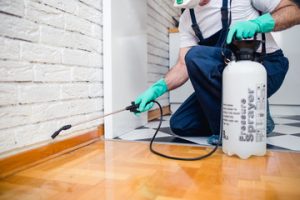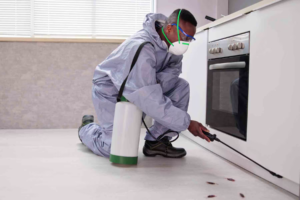Bakersfield Exterminator plays a crucial role in safeguarding homes from the intrusion and damage caused by pests. Their expertise lies in identifying pest problems, implementing appropriate control methods, and preventing future infestations. These professionals rely on a combination of knowledge, skill, and modern technology to ensure homes remain safe and pest-free.

The first step in protecting homes from pests involves a thorough inspection. Exterminators begin by assessing the property to identify the type of pests present and the extent of the infestation. This step is vital as different pests require unique approaches for effective control. They carefully examine both the interior and exterior of the home, paying attention to signs such as droppings, nests, gnaw marks, or damaged structures. Their trained eyes can detect even subtle indications of pest activity that homeowners might overlook.
Once the inspection is complete, exterminators devise a tailored plan to address the specific pest problem. This plan typically involves a combination of methods to ensure effective eradication. They may use chemical treatments, traps, or mechanical methods depending on the type of pests and the severity of the infestation. For instance, chemical treatments might be employed to target termites, while traps could be used for rodents. These professionals are trained to apply treatments in a manner that minimizes risks to humans and pets while maximizing effectiveness against pests.
Preventing future infestations is another critical aspect of an exterminator’s job. After addressing the immediate problem, they take steps to ensure pests do not return. This involves sealing entry points, repairing structural damage, and advising homeowners on best practices for maintaining a pest-free environment. For example, exterminators might recommend keeping food properly stored, addressing moisture issues, and maintaining cleanliness to deter pests. By taking these preventive measures, exterminators provide homeowners with long-term protection.
Education also plays a key role in how exterminators protect homes. They often educate homeowners about the habits and behaviors of pests, helping them understand how infestations occur and how to prevent them. This knowledge empowers homeowners to take proactive steps in keeping their homes pest-free. For instance, they might explain the importance of regular inspections and highlight conditions that attract pests, such as standing water or clutter.
In addition to their technical expertise, exterminators rely on advanced technology and tools to enhance their effectiveness. Modern pest control techniques often involve the use of innovative equipment and environmentally friendly solutions. For example, heat treatments can be used to eliminate bed bugs, while baiting systems are employed for termites. These methods are designed to target pests with precision, reducing the need for widespread chemical applications and minimizing environmental impact.
Another aspect of an exterminator’s work is adapting to the unique challenges posed by each home. Every property is different, and factors such as location, construction, and surrounding environment influence pest activity. Exterminators take these variables into account when developing their strategies. For example, homes near wooded areas might be more prone to termite infestations, while urban dwellings could face issues with rodents or cockroaches. By customizing their approach, exterminators ensure their methods are effective and appropriate for each situation.
Exterminators also play a vital role in addressing seasonal pest issues. Many pests are more active during specific times of the year, and exterminators understand these patterns. They anticipate seasonal pest activity and implement measures to counteract it. For instance, they might focus on mosquito control during warmer months or rodent prevention as temperatures drop. This proactive approach helps homeowners stay ahead of potential problems and minimizes the risk of infestations.
Safety is a top priority for exterminators when protecting homes from pests. They are trained to handle pesticides and other control methods responsibly, ensuring they are applied safely and effectively. Exterminators follow strict guidelines and regulations to minimize risks to people, pets, and the environment. They also take precautions to prevent contamination and ensure treatments are confined to targeted areas. This commitment to safety gives homeowners peace of mind, knowing that their pest problems are being addressed without compromising their health or well-being.
Exterminators often work collaboratively with homeowners to achieve the best results. They provide clear communication about the steps being taken, the expected outcomes, and any necessary follow-up actions. This transparency fosters trust and ensures homeowners are well-informed throughout the process. Additionally, exterminators might schedule regular inspections and maintenance visits to monitor pest activity and address any emerging issues promptly.
In some cases, exterminators may deal with pests that pose significant health risks. For example, rodents can carry diseases, while certain insects can trigger allergies or asthma. By effectively managing these pests, exterminators help protect the health of homeowners and their families. Their efforts not only eliminate existing threats but also reduce the likelihood of future health concerns associated with pests.
Exterminators also understand the importance of addressing the root causes of pest problems. Rather than simply treating the symptoms, they identify and address the underlying factors that attract pests to a home. This might involve improving drainage to prevent water accumulation, sealing cracks and crevices, or addressing landscaping issues that provide shelter for pests. By tackling these root causes, exterminators create an environment that is less hospitable to pests, reducing the chances of recurring infestations.
Homeowners often turn to exterminators for their expertise in dealing with stubborn or hard-to-reach pests. Some infestations, such as termites or bed bugs, can be particularly challenging to manage without professional assistance. Exterminators have the knowledge and tools needed to handle these situations effectively. They employ specialized techniques and equipment to eliminate pests from even the most hidden areas of a home, ensuring a comprehensive solution to the problem.
Another key aspect of an exterminator’s work is staying informed about the latest developments in pest control. The field is constantly evolving, with new methods, products, and technologies being introduced. Exterminators undergo ongoing training to stay up-to-date with these advancements, enabling them to provide the most effective and efficient solutions to homeowners. This commitment to continuous improvement ensures that exterminators remain at the forefront of pest control practices.
Exterminators’ efforts extend beyond individual homes, as they also contribute to broader pest management in communities. By addressing pest problems at their source, they help prevent the spread of infestations to neighboring properties. Their work supports the overall health and well-being of communities by reducing the prevalence of pests and the risks they pose.
Ultimately, exterminators protect homes from pests by combining their expertise, advanced tools, and preventive measures. They address immediate infestations, implement strategies to prevent future problems, and educate homeowners about best practices for pest control. Through their dedication and professionalism, exterminators play a vital role in ensuring homes remain safe, comfortable, and pest-free.
